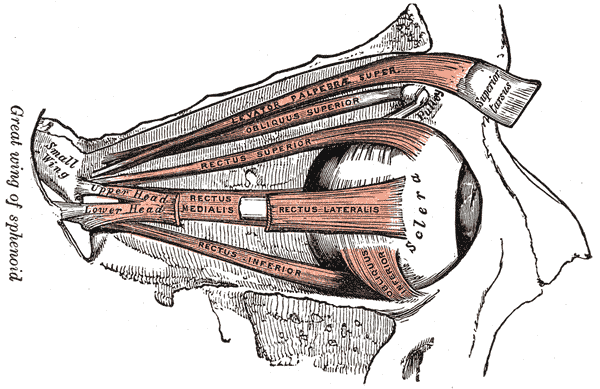[2]
Ng SK, Chan W, Marcet MM, Kakizaki H, Selva D. Levator palpebrae superioris: an anatomical update. Orbit (Amsterdam, Netherlands). 2013 Feb:32(1):76-84. doi: 10.3109/01676830.2012.736602. Epub
[PubMed PMID: 23387464]
[3]
Nijhawan N, Marriott C, Harvey JT. Lymphatic drainage patterns of the human eyelid: assessed by lymphoscintigraphy. Ophthalmic plastic and reconstructive surgery. 2010 Jul-Aug:26(4):281-5. doi: 10.1097/IOP.0b013e3181c32e57. Epub
[PubMed PMID: 20551850]
[4]
Alnosair G, Alhashim H, Alhamoud M, Alturki H. Congenital Ptosis Associated With Adduction as a Dysinnervation Disorder: A Report of a Rare Case. Cureus. 2023 Jun:15(6):e40422. doi: 10.7759/cureus.40422. Epub 2023 Jun 14
[PubMed PMID: 37456445]
Level 3 (low-level) evidence
[5]
Sevel D. The origins and insertions of the extraocular muscles: development, histologic features, and clinical significance. Transactions of the American Ophthalmological Society. 1986:84():488-526
[PubMed PMID: 3590478]
[6]
Zaidman M, Novak CB, Borschel GH, Joachim K, Zuker RM. Assessment of eye closure and blink with facial palsy: A systematic literature review. Journal of plastic, reconstructive & aesthetic surgery : JPRAS. 2021 Jul:74(7):1436-1445. doi: 10.1016/j.bjps.2021.03.059. Epub 2021 Mar 30
[PubMed PMID: 33952434]
Level 1 (high-level) evidence
[7]
Yi KH, Lee JH, Hu HW, Kim HJ. Anatomical Proposal for Botulinum Neurotoxin Injection for Glabellar Frown Lines. Toxins. 2022 Apr 10:14(4):. doi: 10.3390/toxins14040268. Epub 2022 Apr 10
[PubMed PMID: 35448877]
[8]
Sevel D. A reappraisal of the development of the eyelids. Eye (London, England). 1988:2 ( Pt 2)():123-9
[PubMed PMID: 3197869]
[9]
Astle WF, Hill VE, Ells AL, Chi NT, Martinovic E. Congenital absence of the inferior rectus muscle--diagnosis and management. Journal of AAPOS : the official publication of the American Association for Pediatric Ophthalmology and Strabismus. 2003 Oct:7(5):339-44
[PubMed PMID: 14566316]
[10]
Djordjević B, Novaković M, Milisavljević M, Milićević S, Maliković A. Surgical anatomy and histology of the levator palpebrae superioris muscle for blepharoptosis correction. Vojnosanitetski pregled. 2013 Dec:70(12):1124-31
[PubMed PMID: 24450257]
[11]
Akdemir Aktaş H, Mine Ergun K, Tatar İ, Arat A, Mutlu Hayran K. Investigation into the ophthalmic artery and its branches by superselective angiography. Interventional neuroradiology : journal of peritherapeutic neuroradiology, surgical procedures and related neurosciences. 2022 Dec:28(6):737-745. doi: 10.1177/15910199221067664. Epub 2022 Mar 23
[PubMed PMID: 35317633]
[12]
Thakker MM, Huang J, Possin DE, Ahmadi AJ, Mudumbai R, Orcutt JC, Tarbet KJ, Sires BS. Human orbital sympathetic nerve pathways. Ophthalmic plastic and reconstructive surgery. 2008 Sep-Oct:24(5):360-6. doi: 10.1097/IOP.0b013e3181837a11. Epub
[PubMed PMID: 18806655]
[14]
Tong J, Lopez MJ, Patel BC. Anatomy, Head and Neck: Eye Orbicularis Oculi Muscle. StatPearls. 2024 Jan:():
[PubMed PMID: 28722936]
[15]
Yalcin B, Hurmeric V, Loukas M, Tubbs RS, Ozan H. Accessory levator muscle slips of the levator palpebrae superioris muscle. Clinical & experimental ophthalmology. 2009 May:37(4):407-11. doi: 10.1111/j.1442-9071.2009.02067.x. Epub
[PubMed PMID: 19594569]
[16]
Choo PH, Carter SR, Seiff SR. Upper eyelid gold weight implantation in the Asian patient with facial paralysis. Plastic and reconstructive surgery. 2000 Mar:105(3):855-9
[PubMed PMID: 10724242]
[17]
Jacobs SM, Tyring AJ, Amadi AJ. Traumatic Ptosis: Evaluation of Etiology, Management and Prognosis. Journal of ophthalmic & vision research. 2018 Oct-Dec:13(4):447-452. doi: 10.4103/jovr.jovr_148_17. Epub
[PubMed PMID: 30479715]
[18]
Talebian A, Soltani B, Talebian M. Bilateral Ptosis as the First Presentation of Guillain-Barre Syndrome. Iranian journal of child neurology. 2016 Winter:10(1):70-2
[PubMed PMID: 27057192]
[19]
Izadi S, Karamimagham S, Poursadeghfard M. A case of chronic inflammatory demyelinating polyneuropathy presented with unilateral ptosis. Medical journal of the Islamic Republic of Iran. 2014:28():33
[PubMed PMID: 25250274]
Level 3 (low-level) evidence
